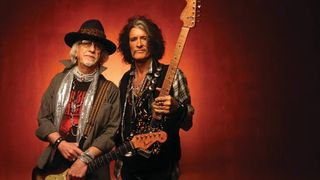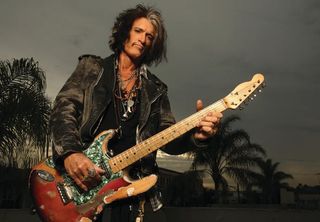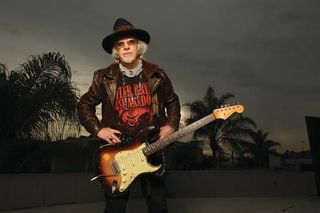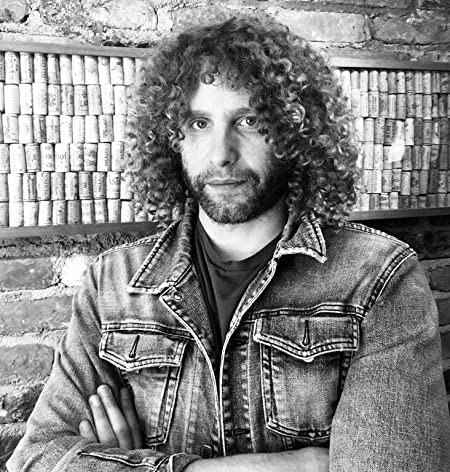Aerosmith's Joe Perry and Brad Whitford Discuss Gear and the Band's Future
Aerosmith's longtime guitarists give GP insight into their future, and an exclusive look inside their Sin City residency.

It’s not often that a band pushing toward its 50th year together can still manage to scale new heights — or even exist, for that matter.
But that’s what Aerosmith have done with Deuces Are Wild, their current show at the Park Theater in Las Vegas. The production — from the stage set to the sound quality to the performance itself — is wholly unlike anything the group has ever attempted in its long career. It is, as guitarist Brad Whitford says, “A completely new experience for this band.”
Which is true, although with one small caveat. As co-guitarist Joe Perry points out, while Deuces Are Wild is indeed Aerosmith’s first extended run in Vegas, it is not actually their first time embarking on a residency.
“We did a residency back when we were first trying to get signed,” Perry tells Guitar Player. “After we went to Max’s Kansas City [in New York] and all the record companies passed on us, our manager said, ‘Well, you’re going to go up to the Sheraton Hotel in Manchester, New Hampshire. We’re booking you in there for two or three weeks, and you can rehearse during the day and play two shows a night.’ That was really our first and, until now, only residency.
“But in some ways it’s the same as this one,” Perry continues. “Because when you do a residency, you get to focus on the music in a different way than you would on a tour. It’s almost like you’re rehearsing or jamming, but with an audience in the room. It’s a really cool thing.”
But Deuces Are Wild is more than a nightly gig — it’s a full-on, sensory-overloading immersive experience. The career-spanning, 90-minute set reaches back to Aerosmith’s 1973 self-titled debut for tracks like “Dream On” and “Mama Kin,” and barrels through classic hits like “Walk This Way,” “Sweet Emotion,” “Dude (Looks Like a Lady)” and “Cryin’,” all while sprinkling in fan-favorite album cuts like “Seasons of Wither” “Hangman Jury” and “Kings and Queens.” All of that music is presented through a state-of-the-art THX and L-Acoustics system that pumps out close to 300,000 watts of multidimensional sound.
Visually, the show dazzles with lights, lasers, fire, dancers, flying toys, a catwalk that extends to the venue’s uppermost seats, a 30-minute intro film that offers a deep dive into the band’s origins, and never-before-seen visuals from the group’s archives presented on 12 massive hi-def screens.
And then, of course, there are the five band members themselves: Perry, Whitford, frontman Steven Tyler, bassist Tom Hamilton and drummer Joey Kramer. Accompanied at times by a string section and horns, they rip through their hot-wired, riff-tasic rock and roll with the energy and vigor of hungry 20-somethings destroying a New Hampshire Sheraton stage in 1972.
“The challenge is to keep the grit and the excitement level of an Aerosmith show while at the same putting up a big flash-bang production,” Perry says about Deuces Are Wild, which runs on and off at the Park Theater (with some East Coast dates sprinkled in) through the end of 2019. “That’s a different kind of a challenge than, ‘Well, it’s time to make another record. It’s time to do another tour.’ I have to say, this is the first time in a long time that I’ve been this excited about something that involves Aerosmith.”
In the following interview, Perry and Whitford give Guitar Player an exclusive behind-the-scenes look at the making of Deuces Are Wild. They also talk gear, their guitar partnership, the state of rock in 2019, and what lies ahead, both onstage and in the studio, for Aerosmith. “One thing that’s for sure,” Perry says, “I don’t see us putting the guitars away anytime soon.”

What led the band to do a Las Vegas residency at this point in its history?
Joe Perry: A couple of things. For the last few years, we’ve been on the road off and on, and it was getting a little monotonous just going out and playing some of the same places we’ve played so many times. So we’d been talking about doing a residency, and how to do it and where to do it. There are different ways to do it. A lot of bands go in and just strip down their show, do eight gigs, and that’s it. But I don’t think a rock band like ours has ever gone in with a full-on production like this.
Back in the ’70s when Aerosmith were on the road constantly, I’m sure it would never have crossed your mind to think, Maybe one day we can just stay in the same place and have the audience come to us.
Brad Whitford: Well, you know, we didn’t really mind the travel in those days. Being in your 20s and stuff, that’s a piece of cake. [laughs] You get older and it becomes a little more wear and tear.
Perry: And there are a lot of benefits beyond that, like not having to worry about different sound every night, the monitor mix in this building or that building, whether there’s an echo in the room. You can just focus on the music. And because of that, we’re able to do things here we wouldn’t normally do onstage, like have a horn section and strings.

The additional instrumentation is one of the particularly cool aspects of the Deuces Are Wild show.
Whitford: We’re trying to be fairly faithful to how the songs were originally recorded. And we do have a number of songs that have horn parts in them. Most of those songs are probably some of the more popular tracks, like “Rag Doll,” “Dude (Looks Like a Lady)” and “Same Old Song and Dance.” Even going back to the first album, there’s a saxophone on “Mama Kin.” As for strings, I don’t know that we actually used real strings on the first record, but we’re using them onstage for “Dream On,” and then also for songs like “I Don’t Want to Miss a Thing.”
Perry: We wanted to give the fans a glimpse of what it would have been like to be in the studio when we recorded some of these songs. And like Brad said, there are a lot of horns on Aerosmith songs. But we’ve never brought horns on the road. So we were thinking, Let’s play the songs as close to “just right” as we can get them. We said, “That’ll be something!” We didn’t know what! [laughs] But we’re finding out.
After almost 50 years together, what is it you most enjoy about playing with each other onstage?
Perry: Just the natural way that we play together. I listen to what Brad’s playing, and he listens to what I’m playing, and then we just try and mix it up, right down to — especially in the earlier days — saying, “Who’s gonna play the Strat? Who’s gonna play the Les Paul?” That kind of thing. And when we come up with new riffs and new songs, we each come at it from different angles, and then we settle into our thing. I’ve always felt like we have two lead players and two different flavors in this band, and that’s really important.
Do you guys feel the partnership has changed at all from the early days to now?
Whitford: In some ways it has, because we’ve both grown as players. But in other ways it’s stayed like it was in the early days. I think we learn a lot from each other. You know, it’s very hard to play some of what Joe does, because it’s so different from what I do. And some of these songs that he’s come up with, it’s just brilliant stuff. I’m not sure where it comes from, because we come from two different places. He’s not schooled at all, so it’s totally a “feel” thing for him, whereas I did a lot more studying of the guitar. So you’re seeing two different approaches, but they work really well together. Ultimately, you want to have both sides. I mean, there’s lots of guys out there that could never read music, but you hear them play and you just say, “Damn!” It’s like if Stevie Ray Vaughan came up and said, “I’m gonna learn how to read music.” You’d say, “Don’t bother! You’ll be fine!” [laughs]
Both of you are also known gear heads, to a certain extent. What are some of the guitars you’re using for these shows?
Perry: I’ve rifled through my collection of really old stuff and have been breaking some of it out for these shows. And in general I just have a lot of guitars with me. Part of it is just out of necessity. For instance, a song like “No More No More” is in an altered open-E tuning, and “Draw the Line” and “Let the Music Do the Talking” are in open G. And then for “Back in the Saddle,” I use a six-string bass. Then for all of those you have to have a spare, too. So it adds up pretty quickly. [laughs]
But one thing I’ve been using a lot onstage is this mongrel guitar. We put it together back in 2000, and it has a left-handed Fender body and a Warmoth neck, I believe. And I had fat frets put on it, and Joe Barden pickups, custom wound, which I don’t know if you can still get or not. That guitar has pretty much become my number one. It’s pretty beat up by now, but that’s an instrument I can always count on and go to.
Also, Gibson just made another signature guitar for me that’s a single-pickup Les Paul goldtop called the Gold Rush, with a Wilkinson whammy-bar setup. It’s got a coil cutter on the tone control and a volume knob and that’s it. And that guitar is a great live guitar. I mean, I don’t dial in that many different sounds with a Les Paul. So I figured, Why not just go for the one-pickup thing?
How about you, Brad?
Whitford: I’ve always been a huge fan of the Les Paul and the Strat. To me it’s like having a screwdriver and a hammer in a toolbox: They’re essentials. And over the years I’ve gathered together a little group of favorites of each. So those are always with me. But I probably use more Stratocaster here in Vegas because it’s a little more versatile for me. I can get it to do all the sounds that I need, and I think I’m just enjoying playing it a little more. I have this one Strat, it’s a ’65 reissue from a few years back when Fender did a series of reissues — a ’59, a ’65 and a ’56, I think. And the guys over there were nice enough to give me one of the ’65s. It’s just a great guitar. You know, when those Strats come together in the right way, whatever that synergy is, it’s just perfect. So I’m using that one a lot. And then I have another Strat that was built for a NAMM show many years ago and is made out of pine. And being made out of pine, it’s light as a feather. And it’s loud! Played acoustically, sitting on the couch without it plugged in, it just rings like crazy. So I love playing that one. And then I have a new Gretsch that I’ve been using a little bit, and of course I’m bringing out a couple of Les Pauls as well.

As guys who have been playing rock and roll for almost half a century now, what do you think of the state of rock in 2019?
Perry: Rock definitely has its place alongside pop and dance and hip-hop and country and all of that. And to me, there’s this feeling of a resurgence, or at least of finding its level again. One thing we’re seeing is there are a lot of younger kids who want to see the real thing — the guys that played the music that they grew up listening to. And there are also a lot of talented younger bands that are coming up with good stuff. Whether they can take it to the next level, that remains to be seen. But I don’t think there will ever be another earth-shaking event like the Beatles. I mean, there could be, but I don’t know.
Whitford: This genre that we’re a part of, it seems like it’s pretty much been overfished. Like, how many great riffs are left? What can you do that sounds new or different? But then there’s a lot of young guys waving the rock flag, and they’re doing a great job at it. I like Rival Sons. They’re not new anymore, but they’re still new-ish. And I like Tyler Bryant & the Shakedown, Blackberry Smoke…guys like that. I feel like they’re doing it the way we did it, and with the same kind of spirit. So I hear a lot of stuff that’s really encouraging.
Perry: The way I see it, it might not be like the days when rock really ruled the roost, but, you know, if 20 percent of the people love rock and roll, 20 percent of the people now might mean 20 times as many people as it did 50 years ago, because there’s just that many more people in the world. And hell, half the good rock and roll I hear these days is in TV commercials! So it’s amazing to me how much the music has become part of the mainstream.
Aerosmith have been touring pretty consistently over the past few years, but it’s been a while since we’ve heard new music from the band. Any chance a studio record is on the horizon?
Whitford: There’s been talk, but it’s just talk. It’s not like we’re sitting there and we’ve got 40 songs to cut. There’s not a lot of material on the table. But we could go in the studio and do something — do some covers, whatever. The key would be to keep it light and keep it fun. That’s what it’s supposed to be about, right?
Perry: I think by playing together in this sort of situation, where we don’t have to get to a different city every night and be in a different venue, it’s going to open up some doors to us getting into a creative mode again, just by changing the paradigm a little bit. So I actually think there’s a good chance something like a new record could come out of this experience.
In 2017, you guys launched a tour called Aero-Verderci Baby!, which many speculated was a farewell outing. But clearly you’re still going strong. Is retirement something the band ever talks about?
Perry: We were thinking about it with that tour. We figured we’d just keep going until we got tired of it. But at one point, we were in South America for some shows, and the five of us were doing press, and none of us could say, “This will be the last tour.” We were all just looking at each other. When the reality of it hit, I was like, Wait a second — I can’t say those words. And I looked over at Steven, and he couldn’t say them either. And we kind of started laughing, because we were gearing this thing up to be the final tour and — well, it wasn’t. So I don’t know. I think after this run we’ll see what we want to do. Maybe we’ll want to more of this kind of stuff.
Whitford: Being players, the only thing that’s really going to stop us is some kind of physical ailment, where maybe we can’t perform the way we used to or can’t perform at all. We’re not there. And there doesn’t seem to be any reason to pack it up if people still would like to come out and see it. So I think we’re just going to keep playing until we can’t anymore. Why not? We all love doing it, so…
I would imagine that even after all these years it’s still a charge going onstage and playing something like “Walk This Way” or “Sweet Emotion” to a roomful of fans.
Perry: It still is, yeah. And what we’re doing with these Vegas shows, it’s a whole other level of that. It’s exciting, and in a new way.
Whitford: Well, a song like “Walk This Way,” it’s one of those classic riffs. It’s always great to play. It goes by way too quickly! But yeah, it’s great to do these songs. You hear them on the radio and stuff and you go, “That’s our band! And we get to play that live!”
It’s like, “I did that!”
Whitford: [laughs] Yup. It’s still a rush.
Player's Choice
JOE PERRY
GUITARS
• Gibson Les Paul Joe Perry Gold Rush
• Gibson Custom “Billie Perry”
• Nelson Admiralcaster
• Gibson Les Paul 1959 Joe Perry signature series
• Guild Blade Runner
• Danelectro electric 12-string
• Dobro electric six-string
• Chandler lap steel
• Ernie Ball Music Man Silhouette six-string bass
• TV Jones Maestro with onboard Wampler Faux Tape Echo
• Fender Stratocaster Burn Guitar
• Fender Telecaster with B-Bender
• Echopark Geisha
• Gibson Songwriter 12-string acoustic
AMPS
• Supro Super
• Supro Black Magick
• Fender Dual Showman Reverb
• Marshall Super PA (vintage)
• Marshall JCM800
• Voodoo Amplification V-Plex
EFFECTS
• DigiTech Whammy
• DryBell Vibe Machine
• King Tone Fuzz
• Klon Centaur
• Klon KTR
• Diamond Tremolo
• Danelectro The Breakdown
• Dunlop Echoplex
• Wampler Tape Delay
• Catalinbread Topanga Reverb
• Electro-Harmonix POG (vintage)
BRAD WHITFORD
GUITARS
• Gibson Les Paul C9 Cloud 9 ’59 Custom Shop, Sunburst
• Charvel Pro Mod SD1, White with Japanese Graphics
• 2019 Gretsch G6228 Players Edition Jet BT with V-Stoptail, Bourbon Stain
• Gibson SG Standard, Cherry
• Gibson Custom Shop Les Paul R7 Goldtop
• Gibson Les Paul Collector’s Choice #28 STP Burst “Ronnie Montrose”
• 1997 Gibson Custom Shop Les Paul, Sweet Cherry, with Bigsby
• Gibson Custom Shop Les Paul Custom ’72 reissue of ’54/’55 Les Paul, Black
• Gibson Custom Shop Les Paul three-pickup Black Beauty with f-holes
• Fender Custom Shop NAMM Pine Strat, Blonde with stop tailpiece
• Fender American Vintage ’65 Reissue, Dakota Red
• Fender Custom Shop Heavy Relic, Black
• Fender Eric Clapton Strat, 7UP Green
• Melancon Pro Artist Strat-style, Gold
• Green Guitar Project BW Tele-style
• J Triggs Tele-style
AMPS
• 3 Monkeys Orangutan head with 6L6 power tubes
• Magnatone Super Fifty-Nine M-80
• 1966 Marshall JTM45 (spare)
• 3 Monkeys 2x12 with Celestion Greenbacks (x2)
• Marshall 4x12 1960BX with Celestion Greenbacks functioning as a 2x12 (x2)
EFFECTS
• Xotic Wah
• Klon Centaur
• Mojo Hand FX Rook
• Strymon Deco
• TC Electronic Quintessence
• King Tone The Duellist
• Vick Audio 73 Ram’s Head
• TC Electronic Corona Chorus
• Eventide H9 Max
• Daredevil Pedals Atomic Cock
• 3 Monkeys Pedalboard
Special thanks to Joe Perry’s guitar tech, Marco Moir, and Brad Whitford’s guitar tech, Greg Howard, for their assistance.
Get The Pick Newsletter
All the latest guitar news, interviews, lessons, reviews, deals and more, direct to your inbox!
Rich is the co-author of the best-selling Nöthin' But a Good Time: The Uncensored History of the '80s Hard Rock Explosion. He is also a recording and performing musician, and a former editor of Guitar World magazine and executive editor of Guitar Aficionado magazine. He has authored several additional books, among them Kurt Cobain: Montage of Heck, the companion to the documentary of the same name.

“Sometimes things like that just come together, like a piece of magic. I wrote that song in just five minutes”: Dickey Betts on dueling with Duane Allman, composing Allman Brothers' biggest hit, and the oddball Les Paul/SG hybrid he “personally designed”

“We all knew it was really good… The guitar playing is just amazing”: How Dickey Betts made “Ramblin’ Man”, triumphed over tragedy and led the Allman Brothers to their greatest success
Most Popular









